This article is provided and brought to you by Investec Structured Products
As the global economy shifts from a high inflation and high interest rate environment into the next interest rate cutting cycle, global investors are casting their net wider in their search for returns.
Stock valuations in the U.S. are at all-time highs despite the higher interest rate environment, with momentum crowding and stock market concentration at multi-decade extremes. Developed markets (DM) outside the U.S. also face headwinds on multiple fronts, with a sluggish eurozone recovery and structural constraints in the UK.
In this environment, investors need to look outside these markets for better returns, with many boosting allocations to emerging markets (EM) following positive shifts in the global growth momentum story.
Supportive tailwinds have brought EM equities back in favour, despite the inherent risks, with a weakening U.S. dollar (USD), global monetary easing, rising income levels and the associated increased demand for products and services supporting corporate earnings.
These regions also constitute a larger share of economic activity and are forecast to deliver higher GDP per capita growth than the developed world.
Consequently, EM equities outperformed DM equities in the third quarter (Q3) of 2024, gaining 8.7% versus 6.4%. This marked two consecutive quarters of EM outperformance for the first time since 2020.
Asia (ex-Japan) was the top-performing major region, returning 10.6% over the quarter. The positive shift began as the Federal Reserve (Fed) cut rates in mid-September, and outperformance accelerated in the final week of the quarter as China unleashed a series of stimulus measures.
However, a significant shift has occurred in the Asian market, with India rising as the next regional powerhouse amid the structural and regulatory challenges that have hamstrung the Chinese economy in recent years.
India’s value proposition boasts numerous facets. For starters, it is one of the fastest-growing EM economies in the world. India’s quarterly real GDP growth has averaged 6% year-on-year over the past decade, which is higher than the global (3%) and emerging market (4.2%) averages over the same period.
The International Monetary Fund (IMF) projects that GDP growth in India will hit 7% in 2024/2025 and average 6.1% over the next five years. This growth rate will make it the world’s third-largest economy by 2027 after the U.S. and China, with current annual GDP expected to double from $3.5 trillion to $7 trillion by 2030.
The Reserve Bank of India (RBI) has also kept inflation in check by expanding fiscal policy and implementing proactive monetary measures that have stabilised the economy. The RBI is expected to prioritise growth with additional rate cuts in early 2025, alongside additional economic reforms aimed at improving the business environment.
The other prolific regional growth driver is rising consumption among the world’s largest population. According to the United Nations, India officially surpassed China as the world’s most populous nation in April 2023, with around 1.43 billion citizens.
This population dividend includes a young (average age of 28), educated and expanding workforce, offering a source of cost-effective labour that will help sustain economic growth.
Moreover, the thriving Indian economy supports diverse industries, including growth sectors like technology and IT services, health care and pharmaceuticals, and renewable energy. Robust and highly competitive manufacturing and business process outsourcing sectors make the country globally competitive while abundant natural resources provide a strong foundation for industrial development and export-oriented industries.
These supportive factors have helped the Indian equity market grow steadily over the past decade. In 2024, the market capitalisation of the National Stock Exchange of India (NSE) surged past $5 trillion, making it the fourth-largest market worldwide and the second-largest emerging market after China.
On the back of strong economic fundamentals, the Indian stock market has emerged as a top global performer. For instance, since the low of the pandemic in March 2020, the blue-chip NSE Nifty 50 has climbed over 200%.
Much of the recent momentum in the Indian equity market is attributed to increased liquidity, with local flows rising due to increasing affluence and access among domestic retail investors.
Rising foreign capital inflows have also bolstered market performance, with small-cap inflows driven by a strong IPO boom among Indian SMEs over the last five years, and record inflows from foreign institutional investors.
The Indian government has supported foreign direct investment by facilitating greater trust and certainty in the local stock market with a series of financial policy adjustments and reforms in recent years. For example, the listing rules of Indian exchanges have been improved to enhance the disclosure of financial information of listed companies.
Additionally, the Indian government has continued to relax restrictions on foreign investment in securities, including the relaxation of foreign shareholding ceilings, industry restrictions, and foreign exchange control, among others.
When considered in totality, India offers a compelling proposition for investors looking to boost their EM exposure and catch the upside potential, with a new Structured Product launched by Investec offering efficient access to the Indian stock market.
The JSE-listed Investec Rand India Accelerator offers 1.5x geared exposure to growth in the iShares MSCI India ETF over a 3.6-year term, capped at 40%, for a maximum return of 60% in rand.
The ETF tracks the large and mid-cap Indian market, covering 85% of India’s listed equity universe, and provides a high degree of capital protection to address the inherent risks associated with investing in EMs.
For more information on the Investec Rand India Accelerator, listen to the podcast with The Finance Ghost and Brian McMillan of Investec Structured Products below, or access the full transcript at this link.
Disclaimer
https://www.investec.com/en_za/legal/structured-products-disclaimer.html




